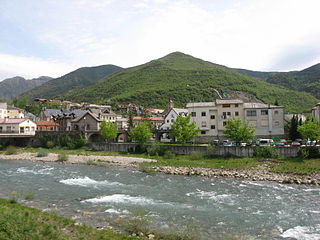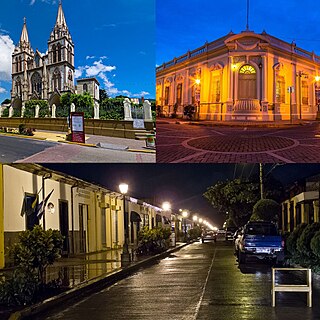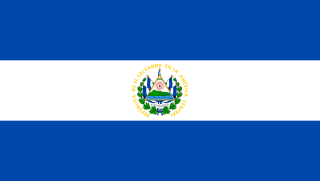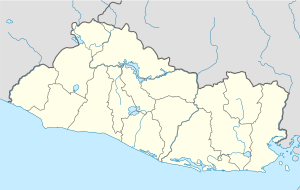
El Salvador is a country in Central America. Situated at the meeting point of three tectonic plates, it is highly seismologically active and the location of numerous earthquakes and volcanic eruptions. The country has a tropical climate.

San Salvador is the capital and the largest city of El Salvador and its eponymous department. It is the country's political, cultural, educational and financial center. The Metropolitan Area of San Salvador, which comprises the capital itself and 13 of its municipalities, has a population of 2,404,097. The urban area of San Salvador has a population of 1,600,000 inhabitants.

Santa Ana is the second largest city in El Salvador, after the capital of San Salvador. It is located 64 kilometers northwest of San Salvador, the capital city. Santa Ana has approximately 374,830 (2017)) inhabitants and serves both as the capital of the department of Santa Ana and as the municipal seat for the surrounding municipality of the same name. For its administration the municipality is divided into 35 colonias (neighborhoods) and 318 small villages.

La Libertad is one of the departments of El Salvador and is located in the southwest of the country. The capital is Santa Tecla. It has area 1,653 km² and a population of more than 747,600 people.

San Salvador is a department of El Salvador in the west central part of the country. The capital is San Salvador, which is also the national capital. The department has North of the Rio Lempa Valley, the "Valle de las Hamacas" and a section of Lake Ilopango. Some of the department's cities that are densely populated are: San Salvador, Ciudad Delgado, Mejicanos, Soyapango, Panchimalco and Apopa. The department covers an area of 886.2 square kilometres (342.2 sq mi) and the last census count in 2017 reported 2,404,097 people. It was classified as a department on June 12, 1824. During the time of the colony, the department was the San Salvador Party, from where territory was taken to make the departments of Chalatenago, La Libertad, Cuscatlán and La Paz. This department produces beans, coffee, sugar cane, etc. for agriculture, on the other hand San Salvador Department holds many headquarters for banking companies in El Salvador and Central America, and for many communication services, also the headquarters of the electric companies are located in the San Salvador Department, last years these companies took a step and started exporting electricity to all Central America. The current mayor of the department is Ernesto Muyshondt (2015-2019)
La Libertad can refer to:

The culture of El Salvador is a Central American culture nation influenced by the clash of ancient Mesoamerica and medieval Iberian Peninsula. Salvadoran culture is influenced by Native American culture as well as Latin American culture. Mestizo culture and the Catholic Church dominates the country. Although the Romance language, Castilian Spanish, is the official and dominant language spoken in El Salvador, Salvadoran Spanish which is part of Central American Spanish has influences of Native American languages of El Salvador such as Lencan languages, Cacaopera language, Mayan languages and Pipil language, which are still spoken in some regions of El Salvador.

Biescas is a municipality of northeastern Spain close to the border with France, in the midst of the Pyrenees in the province of Huesca. The name seems to provide from the term bizka, which means "hill" in a Proto-Indo-European language.

Antiguo Cuscatlán(colloquially known as Antiguo) is a municipality in the La Libertad department of El Salvador, and its eastern tip lays in San Salvador Department part of the Metropolitan Area of San Salvador, southwest of San Salvador and southeast of Santa Tecla. The population was 48,027 at the 2010 census. Antiguo Cuscatlán can be translated as Old Jeweled City: Antiguo means ancient or old in Spanish, and Cuscatlán means jeweled city in Nahuat. The city used to be the capital of the Pipil or Cuzcatecs, before the Spanish conquest of the New World.
Huizúcar is a municipality in the city of La Libertad in El Salvador. The town of Huizúcar is the head of the Huizúcar district in the city of La Libertad. This town is 23 kilometers away from San Salvador and has an elevation of 640 meters above sea level. The patron saint of the town is Saint Michael the Archangel.
Jayaque is a municipality in the La Libertad department of El Salvador. According to the 2007 census, Jayaque has a population of 11,058. It covers an area of approximately 18.5 square miles (48 km2) and has an altitude of 3,215 feet (980 m) at its highest elevation. The Nahuatl place-name Jayaque, Shaycat or Xayacatepeque, translates to "Hill of the masked" or "Hill of the masks or of the enamored ones."
La Libertad is a municipality in the La Libertad Department of El Salvador. It had a population of 35,997 inhabitants in 2007 according to the official census of that year. It is one of the main tourist attractions in the country.

Nuevo Cuscatlán is a municipality of El Salvador, belonging to the department of La Libertad, it is located 13 kilometers from San Salvador. It borders to the north and east with Antiguo Cuscatlán, to the south with Huizúcar and San José Villanueva and to the west with Santa Tecla.

Santa Tecla is a municipality in the La Libertad department of El Salvador. It is the capital of the department of La Libertad.

The Cathedral of the Savior or La Seo de Zaragoza is a Roman Catholic cathedral in Zaragoza, in Aragon, Spain. It is part of the World Heritage Site Mudéjar Architecture of Aragon.
San Jose Villanueva is a small municipality in the Department of La Libertad, El Salvador. San Jose Villanueva has a population of 14,000 inhabitants and 9,896 inhabitants. It is located in the south of the Department, bordered by the cities of Nuevo Cuscatlán to the north, Huizucar to the east, the port of La Libertad to the south and Zaragoza to the west. The town contains a health clinic, six schools, an institute, a Catholic church, and seven Protestant churches. In the last several years, the municipality has seen an influx of the upper middle class, including the introduction of a gated housing development. Principal crops include grains, coffee, and grasses. There are businesses in cattle, pigs, and poultry. Among the successful industries are the Beneficiary of Coffee and the Dairy Elaboration. There are paved access roads. Of note is a local archaeological site, the Piedra Pintada, a rock inscribed with three meters of ancient hieroglyphics.

San Andrés is a pre-Columbian site in El Salvador, whose occupation began around the year 900 BC as an agricultural town in the valley of Zapotitán in the department of La Libertad. This early establishment was vacated by the year 250 because of the enormous eruption of the caldera of Lago Ilopango, and was occupied again in the 5th Century, along with many other sites in the valley of Zapotitán. Between 600 and 900 AD, San Andrés was the capital of a Maya polity with supremacy over the other establishments of Valle de Zapotitán.

Salvadorans, also known as Salvadorians, are citizens of El Salvador, a country in Central America. Most Salvadorans live in El Salvador, although there is also a significant Salvadoran diaspora, particularly in the United States, with smaller communities in other countries around the world.

Sos del Rey Católico is a historic town and municipality in the Cinco Villas comarca, province of Zaragoza, in Aragon, Spain.
La Laguna is a municipality in the Chalatenango department of El Salvador.

















